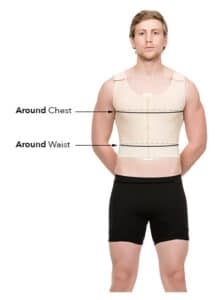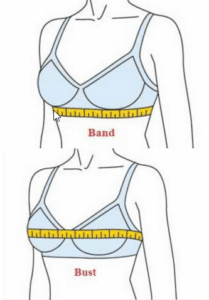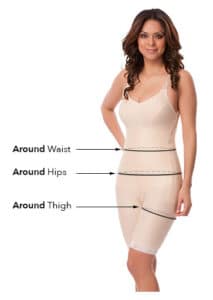Options for Post-Surgery Garments after Breast Surgery
Following breast surgery, the right support garment plays an essential role in your recovery process. These garments, specifically designed for post-operative care, help manage swelling, support healing tissues, and ensure comfort during the recovery period. Support garments are not just any piece of clothing; they are engineered with features that aid in your recovery. They offer a combination of support and compression, which is necessary for managing post-surgical symptoms and enhancing comfort. Wearing post-surgery support garments after breast surgery can significantly impact your recovery speed and comfort level.
Sydney Specialist Plastic Surgeon Dr Bish Soliman is here to help you understand all about post-surgery support garments.

The Role of Support Garments in Recovery
Support garments play an indispensable role in the post-operative recovery phase following breast surgery. Their primary function is to facilitate healing, offer comfort, and reduce the risk of complications such as swelling and fluid build-up.
These garments provide consistent compression to the surgical area. This compression is not merely for comfort; it significantly reduces swelling and minimises the risk of fluid collection, known as seromas. By applying gentle pressure on the tissues, support garments help in maintaining the contour of the surgical site, aiding in a smoother healing process.
Comfort is a significant factor in any recovery process. Support garments are designed to eliminate seams, wires, and other elements that might irritate the sensitive post-surgery skin. They are made from soft, breathable fabrics that not only feel gentle against the skin but also allow it to breathe, reducing the risk of irritation and infection.
Moreover, these garments play a role in reducing pain post-surgery. By securing the surgical area, movements that can cause pain or disrupt the healing process are minimised. This support is especially important in the first few weeks following surgery when the tissues are still healing.
The effectiveness of support garments in preventing complications cannot be overlooked. By ensuring a snug fit, they help in keeping the surgical area stable, reducing the chances of the wound reopening or the implants shifting, should you have them. This stability is important for achieving the desired aesthetic outcome and preventing additional corrective surgeries.
Types of Post-Surgery Support Garments
After breast surgery, selecting the appropriate support garment is important for your recovery. There are several types of support garments designed to cater to the various needs of individuals recovering from breast surgery. Each type offers distinct features and benefits, tailored to support the healing process and provide comfort.
- Compression Bras: These bras are engineered to offer even pressure across the chest area, helping to reduce swelling and minimise the risk of fluid build-up. They usually feature front closures for ease of use, especially immediately after surgery when movement may be restricted. Compression bras are essential for maintaining the shape of the surgical area and ensuring implants, if present, stay in place during the healing process.
- Surgical Vests: Surgical vests provide comprehensive support to the upper body, including the chest, back, and sometimes the abdomen. They are particularly useful for patients who have undergone extensive surgeries, offering a higher level of compression and support over a larger area. These vests often include adjustable straps and front closures to accommodate swelling and changes in body size during the recovery period.
- Front Closure Bras: Designed for convenience and comfort, front closure bras are a staple in post-surgery recovery. The front closures allow for easy dressing and undressing, which is particularly beneficial when mobility is limited. These bras provide gentle compression and support, making them suitable for use during the latter stages of recovery when the swelling has subsided but support is still necessary.
Choosing the Right Support Garment after Breast Surgery
The appropriate garment not only ensures comfort but also significantly impacts the healing process. Here are some factors to consider and steps to follow to ensure you choose the most suitable support garment after breast surgery.
- Material: The fabric of your support garment should be soft, breathable, and offer adequate compression without causing irritation. Look for materials that wick away moisture to keep the surgical area dry and reduce the risk of infection. Fabrics with a blend of cotton, spandex, or microfiber are often recommended for their comfort and elasticity.
- Size: Proper sizing is essential for the effectiveness of a support garment. A garment that is too tight may restrict blood flow and exacerbate swelling, while one that is too loose will not provide the necessary support. It is important to measure yourself accurately and consult sizing charts provided by manufacturers. Keep in mind that your body size may change due to swelling after surgery, so selecting adjustable garments can be beneficial.
- Compression Level: The level of compression should be sufficient to support the healing tissue and reduce swelling without causing discomfort or hindering circulation. Dr Soliman and his team can offer guidance on the appropriate level of compression based on the type of surgery you have undergone and your individual healing process.
How to Measure Yourself for a Support Garment
- Band Size: Measure under your bust, where the band of the bra sits. Ensure the tape measure is firm but not tight.
- Bust Size: Measure at the fullest part of your bust, keeping the tape measure level but not tight.
- Waist and Hip Measurements (for vests): Measure your waist at its narrowest point and your hips at their widest point if you’re choosing a garment that also supports the abdomen or hips.
Look for garments with front closures, adjustable straps, and seamless designs to ease the process of putting on and taking off the garment, especially when movement is limited.



Benefits of Wearing Post-Surgery Support Garments
The advantages of wearing post-surgery support garments extend beyond mere comfort; they play an important role in the healing process after breast surgery. Understanding these benefits can underscore the importance of incorporating these garments into your recovery plan:
- Support and Stabilisation: One of the primary benefits of post-surgery garments is the support and stabilisation they provide to the surgical area. This is particularly significant in the case of breast surgeries where maintaining the position of implants, if used, or supporting the natural breast tissue during the healing process is essential. Adequate support helps in reducing movement that can lead to discomfort or disrupt the healing process.
- Pain Management: Wearing the right support garment can significantly reduce pain during the recovery period. By limiting excessive movement and providing gentle compression, these garments can alleviate pain and discomfort, making the recovery process more manageable. The compression also aids in reducing the sensitivity of nerve endings around the surgical site.
- Shape Retention: Post-surgery garments help in maintaining the contour and shape achieved through surgery. This is important for surgeries where the aesthetic outcome is a significant concern, such as breast augmentation, reduction, or lift. Consistent wear ensures that tissues heal in the desired position, contributing to the success of the surgical outcome.
- Reducing Swelling and Preventing Complications: The compression provided by support garments is essential in managing post-operative swelling. By encouraging the removal of fluids from the surgical area, these garments help in reducing swelling more rapidly. This not only speeds up the healing process but also minimises the risk of complications such as seromas or lymphoedema, which can arise from fluid accumulation.
- Enhancing Circulation: Improved circulation is another significant benefit of wearing compression garments. By facilitating blood flow, these garments help in delivering oxygen and nutrients to the healing tissues, which is important for a smooth recovery. Enhanced circulation also aids in the removal of waste products from the surgical site, further reducing the risk of complications.
How Long do you Wear Your Support Garments after Breast Surgery?
The duration for wearing a post-surgery support garment is an aspect of your recovery process directly influencing your comfort and the outcome of your surgery. While individual recommendations will vary based on the type of surgery and your unique healing process, there are general guidelines that can help you set expectations for how long you might need to wear these garments:
- Guidance from Your Plastic Surgeon: The most accurate advice regarding how long to wear a support garment comes from your plastic surgeon. Based on the specifics of your surgery and how your body is responding to recovery, he can give you tailored advice. Typically, the minimum duration for wearing a support garment is around four to six weeks, but this can extend depending on your healing progress.
- Listening to Your Body’s Needs: Besides professional advice, paying attention to your own body is important. If you experience discomfort, swelling, or other signs that your body might still benefit from the support garment, it’s important to continue wearing it. Conversely, if the garment becomes uncomfortable or too loose due to reduced swelling, it might be time for a fitting adjustment or to transition out of it.
- Adjustments Over Time: As your body heals, the level of support and compression needed will change. Initially, a higher level of compression may be necessary to manage swelling and support healing tissues. As the swelling reduces and your body starts to recover, you may transition to garments with less compression or wear them for shorter periods throughout the day.
- Long-Term Use for Comfort and Support: Even after the critical initial recovery period, some individuals choose to continue wearing support garments for additional comfort and support, especially during physical activities or long periods of standing or walking. This choice is personal and should be made based on your comfort and the recommendations of Dr Soliman and his team.
Care and Maintenance of Garments after Breast Surgery
The effectiveness of your post-surgery support garment largely depends on how well it is cared for. Proper maintenance ensures the garment retains its compression and support qualities over time, contributing to a more comfortable and effective recovery. Here are some guidelines for the care and maintenance of your support garments:
Washing and Drying Tips:
- Hand Washing: Hand washing is often recommended to preserve the fabric’s elasticity and compression qualities. Use mild, fragrance-free detergent and lukewarm water. Gently work the soap through the garment, rinse thoroughly, and press out excess water without wringing, as wringing can damage the garment’s fibres.
- Machine Washing: If machine washing is necessary, use a gentle cycle and place the garment in a mesh lingerie bag to protect it. Again, use mild detergent and avoid fabric softeners, which can break down the compression fabric.
- Drying: Air drying is the best option for support garments. Lay the garment flat in a well-ventilated area out of direct sunlight, which can degrade the fabric’s elasticity. Avoid using tumble dryers, as the heat can damage the compression fibres.
When to Replace Your Garment:
- Signs of Wear: Over time, support garments may stretch out or become damaged, losing their ability to provide adequate compression. Regularly inspect your garment for signs of wear, such as thinning fabric, fraying seams, or loss of elasticity.
- Changes in Size: Your body size may change as swelling decreases or if you gain or lose weight during the recovery period. Ensure your garment fits properly throughout your recovery; if it becomes too loose or tight, it may be time for a replacement.
Rotation of Garments:
- Having multiple support garments is beneficial for maintaining hygiene and ensuring continuous support. Rotating garments allows for regular washing and resting of each piece, preserving their condition over longer periods.
Storing Your Garments:
- When not in use, store your support garments in a cool, dry place. Fold them gently without stretching or compressing the fabric to maintain their shape and effectiveness.
FAQs about Support Garments after Breast Surgery
Can I wear my regular bra after breast surgery, or do I need a special support garment?
- After breast surgery, it’s advised to switch from your regular bra to a special support garment designed for post-surgery recovery. These garments offer the necessary compression and support to aid in healing, reduce swelling, and maintain the surgery’s results. Regular bras may not provide the appropriate level of support and could hinder the healing process.
How do I know if my support garment is too tight or too loose?
- A properly fitting support garment should feel snug but not overly tight. You should be able to breathe comfortably and not experience any pain or pinching. Signs that your garment is too tight include difficulty breathing, numbness, tingling, or skin indentation. If it’s too loose, it may move around, bunch up, or fail to provide adequate support. Consulting with your plastic surgeon for a fitting can ensure you have the correct size.
When can I stop wearing my support garment during the day and only wear it at night?
- The transition from day to night-only wear depends on your specific recovery progress and the advice of your healthcare provider. Generally, this transition occurs when you’ve significantly healed and swelling has decreased, which can vary from weeks to months post-surgery. Dr Soliman will guide you based on your healing and comfort level.
Can wearing a support garment improve the shape and appearance of my surgical results?
- Yes, wearing a support garment as recommended can play an important role in shaping and maintaining the appearance of your surgical results. These garments help to stabilise the breast tissue and implants (if used), reduce swelling evenly, and support the new contours of your chest as it heals, contributing to an optimal surgical outcome.
Is it necessary to wear a support garment after a non-invasive breast procedure?
- While non-invasive procedures may not require the same level of compression as surgical interventions, wearing a light support garment or a comfortable, non-wire bra can offer gentle support and comfort during the healing process. It’s best to follow the specific recommendations of Dr Soliman based on the procedure you’ve undergone.
Further Reading about Breast Surgery with Sydney Specialist Plastic Surgeon Dr Bish Soliman
- Read more about 10 Questions You Must Ask Your Surgeon before a Breast Augmentation
- Read more about Minimising Breast Augmentation Scars
- Read more about How to Choose the Best Bra after Breast Augmentation
- Read more about Should I Wear A Sports Bra After Breast Augmentation?
- Read more about Recovery after Breast Augmentation
Medical References about Support Garments after Breast Surgery
- The Use of Postoperative Compression Garments in Plastic Surgery—Necessary or Not? A Practical Review – PubMed
- The importance of compression after plastic surgery – American Society of Plastic Surgery
- Optimising breast support in female patients through correct bra fit. A cross-sectional study – Science Direct
- What to Expect After Breast Reconstruction Surgery – American Cancer Society
- Effect of Compression Garments on the Ventilatory Function After Abdominoplasty – Oxford Academic



